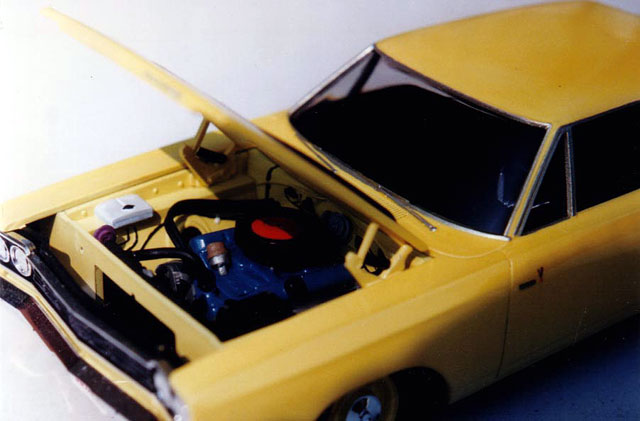Introduction
Here is AMT's 1/25 Scale 1968 Plymouth Road Runner
Pontiac Motor Division of General Motors is generally recognized as
inventing the American musclecar in 1964, when they dropped a “big”
389-cubic inch V-8 engine into the lightweight, midsized Tempest
body and called the result the GTO. It caught on immediately, and
within two years most of the other American carmakers had caught up
with musclecars of their own.
But within just three years, the typical musclecar was already
starting to grow too fat, too flashy, and--most importantly--too
expensive for its intended market, the young car buyer. Some genius
at Plymouth recognized this fact and for the 1968 model year,
reinvented the musclecar anew, using Pontiac’s original idea of a
moderately strong engine in a lightweight midsize body. They put a
335-horsepower, 383-cubic inch engine
in a no-frills, no-chrome Satellite body and called it the Road
Runner, licensing
the popular cartoon character from Warner Bothers. It had a horn
that went “Meep-meep!” (So did my ‘61 VW Beetle, if you tooted
it twice!)
The Road Runner was initially available only in a two-door post
coupe body; hardtop and
convertible were added later. The only optional engine was the
legendary 426-CI Hemi (a three-two-barrel carbed 440 would be
available in 1969).
Paint and interior color choices were also very limited, at least
to start with.

Road Runner in Plastic
The Road Runner was never kitted as an “annual’ in 1968, though
Jo-Han had it in ‘69. We’d have to wait 20 years for AMT to make us
a ‘68 Road Runner. When they did, they
sort of missed the whole point (in my opinion) by equipping the kit
with the optional Hemi engine and the equally optional Motor Wheel
Corp. Magnum 500 styled steel wheels.
I wanted my model Road Runner to more accurately reflect its true
humble roots, so I swapped out the Hemi for a more basic 383 from an
MPC ‘69 Barracuda. The kit Magnum 500 wheels went into the parts box
too, replaced by painted steel open wheels and “dog dish” hubcaps
from a Jo-Han ‘68 Plymouth Fury police car kit. With one other small
exception, my model is otherwise straight out of the box, and in
fact is built in OOB style, as if AMT had kitted it that way.
That sole exception is that I added two pieces of insulated wire
between the firewall and the engine to represent the heater hoses.

It is amazing what this small modification does to the engine
compartment of a model car. It gives, at first glance, the illusion
of the engine being fully wired and “plumbed” without that being
done at all! The effect is so striking that this model once won a
large “best of show” trophy over a large field of
musclecar models, many of which were fully wired and detailed! (Much
to my own amazement, I must hasten to add!)

Painting
I painted my Road Runner with a yellow blended from Model Master
Bright Yellow and Classic White. It’s just a shade “yellower” than
the factory color should be; I found if I went lighter, the color
started to look a bit beige. The solid, un-clearcoated paint was
rubbed out with Wright’s Silver Creme, a mildly abrasive silver
tableware polish. The engine is Model Master Chrysler Engine blue,
and the interior was airbrushed Model Master Black Chrome trim,
which does an excellent job of simulating the black vinyl interior
(a midyear option, by the way).
I made the windshield washer tank look half-full by airbrushing the
top half white and the bottom half blue, then airbrushing the entire
tank with more thin flat white
until the blue just barely showed through--another easy but
effective illusion!

Oh, the model is not light in the front and darker in the back; it
is the same shade of yellow overall. Apparently I was having a
problem with my camera shutter on the day I took these photos.
Model on!